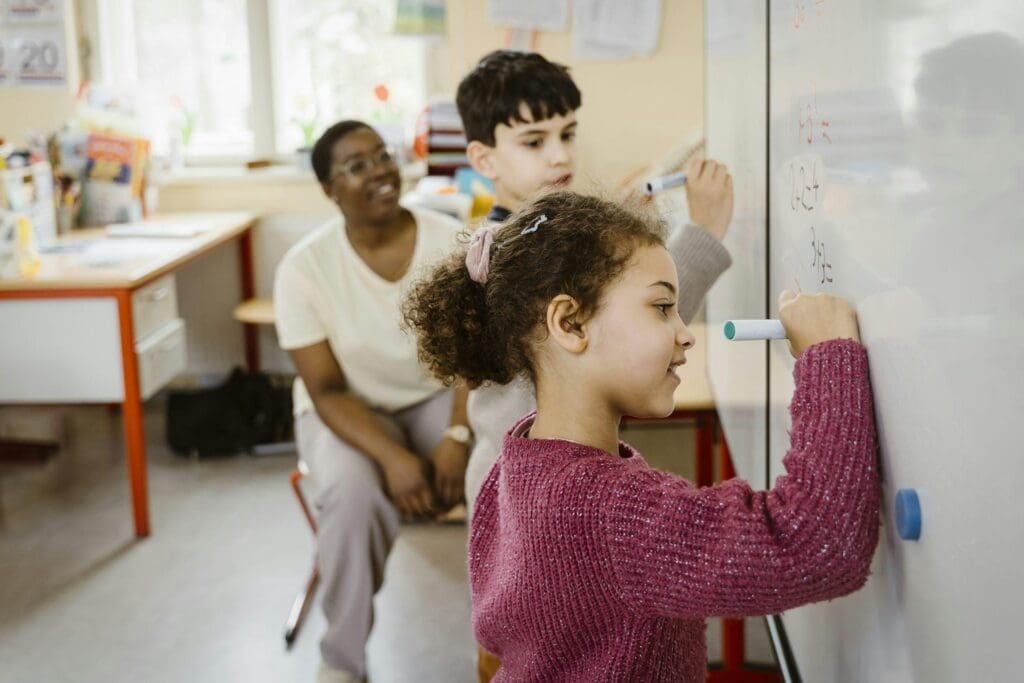Teachers report thinking that if girls do better in math than boys, it is probably because of their innate ability and effort. But they also report that when boys do well in math, it is more likely due to parental support and society’s higher expectations for their success.
That’s what we discovered from 400 elementary and middle school math teachers we surveyed across the country for our new study. The purpose of the study was to learn more about how teachers explain students’ success and failure in math.
We found that the variation in views among educators is not limited to the gender of students. Teachers also hold contrasting views about math performance when it comes to students’ race and ethnicity, our study found.
More specifically, we found that when Black and Hispanic students outperform Asian and white students, teachers are more likely to think it’s because of effort and differences in their cognitive abilities. In contrast, when Asian and white students outperform others, teachers attribute it to the support and expectations of others, such as from parents and society as well as cultural differences that value math learning.
To reach these conclusions, we conducted an experiment. In the experiment, teachers were first asked to help us by reviewing student responses to items on a math test we were developing. After they rated the student responses, we randomly assigned teachers to conditions telling them that one group – either boys or girls, Black and Hispanic or Asian and white – performed better on this test. Then, we asked the teachers to rate their agreement with a set of potential explanations for the disparity. These potential explanations included statements such as, “Boys often pay more attention and follow directions in class compared with girls.”
After teachers had rated their agreement with these explanations, we asked them about their personal beliefs and experiences with gender and racial discrimination in math classrooms. We analyzed how these beliefs related to their explanations of performance differences.
We found that teachers were more likely to attribute the success of girls and Black and Hispanic students to internal factors, such as ability and effort, whereas they were more likely to attribute boys’ and Asian and white students’ success to external factors, such as parental involvement and cultural differences.
We also observed that teachers who reported personally experiencing racial discrimination in math classrooms when they were students were more likely to agree that ability was responsible for Black and Hispanic students’ higher performance.
How teachers explain student performance can affect their expectations of students. It can also affect how they teach and how they emotionally respond to student needs.
For example, research has shown that when teachers attribute students’ failure to a lack of effort, they tend to maintain higher expectations of students and encourage them to expend more effort next time. When they attribute student failure to a lack of ability, however, evidence shows that teachers are more likely to lower their expectations and express more pity. Lowered expectations and feelings of pity can be internalized by students. This can in turn lead them to assume that they have low ability and expect to fail more often in the future.
Findings from our study show that teachers tend to explain students’ failures and successes differently based on which social group performed better than another. Sometimes, these attributions were consistent with stereotypes, such as attributing the higher performance of white and Asian students to their parents and culture.
Our research, along with that of others, shows that implicit biases exist in math classrooms. These biases influence how teachers view students’ abilities and explain their performance. However, most existing anti-bias training interventions are not very effective.
Researchers need to develop new types of training to combat these biases in math classrooms, which could help improve teaching and reduce cognitive and emotional burdens that students experience.
This article is republished from The Conversation, a nonprofit, independent news organization bringing you facts and trustworthy analysis to help you make sense of our complex world. It was written by: Yasemin Copur-Gencturk, University of Southern California; Ian Thacker, The University of Texas at San Antonio, and Joseph Cimpian, New York University
Read more: Math teachers in virtual classes tend to view girls and Black students as less capable The key to fixing the gender gap in math and science: Boost women’s confidence Former math teacher explains why some students are ‘good’ at math and others lag behind
Yasemin Copur-Gencturk receives funding from the NSF, IES, and Herman & Raseij Math Initiative.
Ian Thacker receives funding from the Spencer Foundation and the U.S. Department of Agriculture, National Institute of Food and Agriculture.
Joseph Cimpian receives funding from the Institute of Education Sciences, the National Science Foundation, and the Spencer Foundation.
